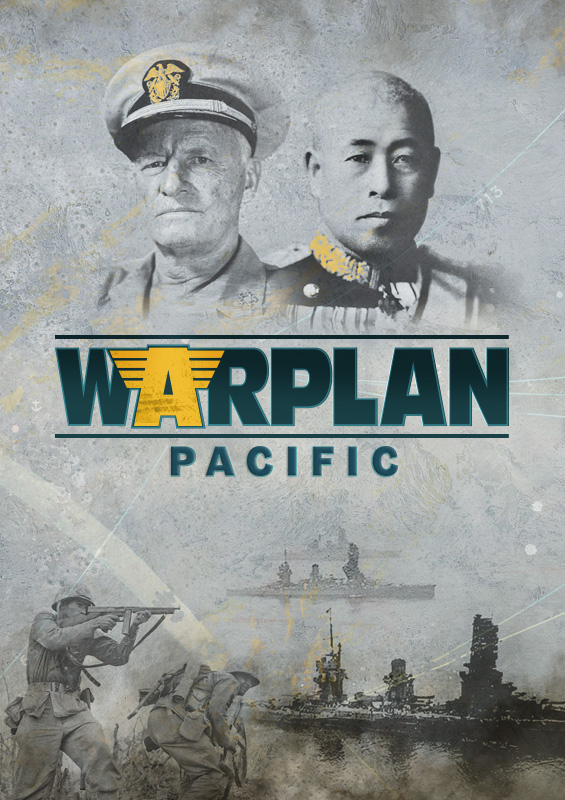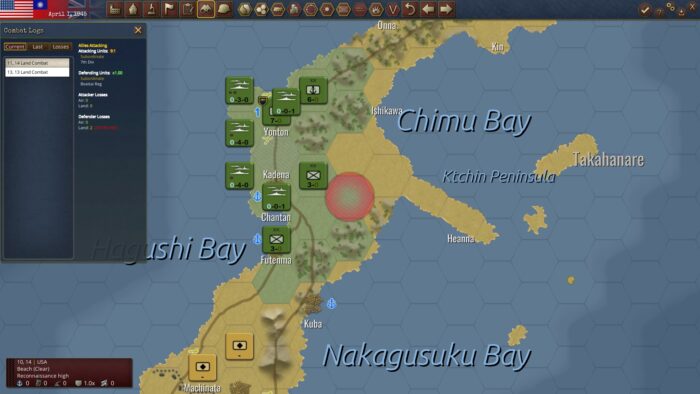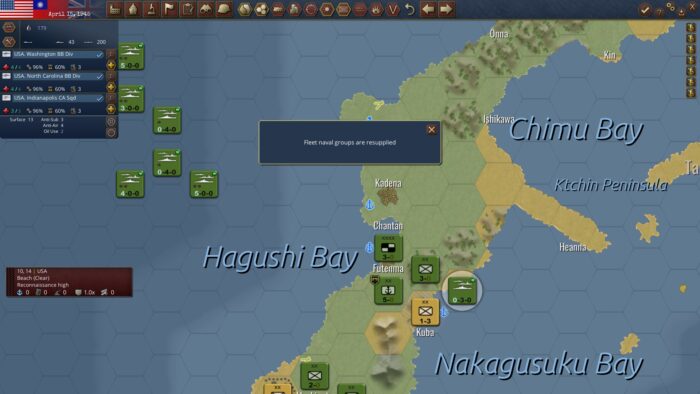Grogheads Impressions: WarPlan Pacific!
WarPlan Pacific is the latest World War 2 strategy game released by Slitherine/Matrix Games and developed by Kraken Studios. It is an operational level wargame covering all the nations at war in the Pacific theater of operations from December 1941 to 1945, on a massive game scale. Using the same game system as its predecessor, WarPlan Europe, WarPlan Pacific ships with many additional features and improvements. We took WarPlan Pacific for a spin to give you our initial impressions on just how well the mechanics of the game system translate to the war in the Pacific.
By: Boggit
WarPlan Pacific is a strategic-operational level game set in World War 2 during 1941-1945 for its main Pacific campaign and set during 1937-1939 for its Sino-Japanese war scenario. Each turn represents two weeks of real time. On map game units are represented as naval groups, land forces at the divisional through to army level and air units as air groups. Support units also exist, but these are handled abstractly. Within each category of unit there are detailed sub categories which function differently in their use. For example, air units are represented by four main combat specialties such as interception or ground attack groups, naval units have six specialties and land units up to eight. The game offers 5 diverse campaign scenarios ranging from the relatively small Okinawan Campaign to the mid-size Solomons Campaign to the full grand campaign covering the entire Pacific war. This is an extremely ambitious game that involves a lot of factors in a very integrated way.

WarPlan Pacific ships with five diverse campaign scenarios, evenly spread through the period 1937-1945.
In my opinion WarPlan Pacific is not an immediately intuitive wargame. It is one of those rare games that are very deep and nuanced. As a veteran gamer, I can usually dive in straight away and get going with a game with very little difficulty. This was not the case with WarPlan Pacific. I tried to dive in and play but initially failed miserably due to not understanding how to play the game in a practical sense. It’s not that a player can’t jump in and play, but without understanding how the game works and the interdependence of various factors, it is hard to properly understand how things are happening within the game. It is a complex game that looks simple, but it has a really steep learning curve if a player is going to get the best out of it.

The production panel is where a player controls the building of new units. There is a wide variety of units for a player to choose from, and here I illustrate the support units in the game. Support units are not actively represented on the map, but play vital roles abstractly with the game engine and are essential for long term success.
Unfortunately, WarPlan Pacific lacks a dedicated tutorial to get a player up to speed quickly. The closest to a tutorial is the Okinawa campaign scenario as it only uses some aspects of the full game. It also serves to showcase how the game editor can be used to create smaller scenarios. There are some good independently created YouTube tutorials available, and a well written manual supplied with the game, so there is a solution. If a player is unwilling to invest the time reading the manual, or to watch lengthy tutorial videos in order to understand the game and its mechanics, then they are setting themselves up for a very frustrating experience. For a new or casual player, the time and effort required to learn the game may be quite off putting and may limit its appeal to some. Once a player knows what on earth is going on with the game, it becomes a mostly streamlined and engrossing title.
Despite the lack of ‘official’ tutorials, there is an interactive help button, which is really useful when you first play the game, but new players are not recommended to diving right into WarPlan Pacific without first checking out the manual and/or the independently produced tutorial videos.

The composition of naval forces may be set in port to create tailored groups. Here we see the composition of a surface combat naval group. The named capital ships will also contain attached support ships in the form of destroyers and maybe a light cruiser. The game also includes specific destroyer groups composed of light cruisers and or destroyers, but these are specialized for other tasks rather than as pure support for capital ships. Part of the knack of the game is to understand how different naval groups interrelate, so that they act to their strengths and the player can mitigate their weaknesses with more appropriate naval groups. The same applies for air groups, for example, a player can ensure that bombers have interceptor groups available as escorts if such groups are set to full support mode with unused action point. Without such support enemy interceptor groups will make the bombers life a misery!
OK, let’s move on to how the game plays in terms of mechanics. It’s a turn based game representing two weeks of real time. During a turn a player can make strategic choices and operational choices with their units.
The strategic choices involve decisions about diplomacy, unit production, industrial planning, research, convoy management, reviewing reports and statistics in order to refine your plans, etc. Each of these has costs and benefits that must be considered, before committing to making those choices.
For example, ship building is limited by the number of shipyards and resources available. Land units can only be produced if the country has the logistical infrastructure to support the extra units. Given that units also take time to appear this means that it is important to plan your strategy in advance, as once a player has committed industrial capacity, resources, etc. to a specific strategy it is difficult to readjust if circumstances change rapidly. There is no point just building more carriers as the Japanese if that just leaves the player with few resources left to protect themselves with escorts or destroyer groups against a determined Allied submarine campaign that wrecks the convoy supply chain.

Air and land units can coexist as multiple units in a hex. There are limits on what can be stacked in any given hex, but overall it is well managed in the game.
The operational side is the most active part of the game. This is where the player will move and fight on the main map, and this is a potentially a very involved process. Fighting and movement is controlled to the extent of the operation points available to a unit which act as a brake on the extent of movement and combat. Each move uses up operation points, as does each combat. Air and naval units each have two operation points, allowing them to move and fight, or fight twice. Land units have more operation points, which notionally allow for more attacks and movement opportunities. However, land movement is affected by terrain and enemy units, which in turn create a movement expense on operation points, which can slow the pace of operations.

The unit detail panel gives most relevant information at a glance. I have enhanced the detail a bit for easier viewing. A player must be careful when examining information on the detail screen as you can inadvertently reallocate anti-air to the pool, increase truck supply support and even embark the unit for a landing, and I have highlighted these buttons with a red star for more clarity. I have found no way back from this, and although there is an undo button when the player actually moves the unit, there is none for pressing these icons by accident and a player has to live with the consequences. Fortunately some buttons on the unit detail like combat mode operate as a toggle, so if a player makes a mistake they can correct it before ending their turn.
There are a lot of interactive features that apply to operational combat. For example, supply trucks can be expended to increase supplies, anti-aircraft guns can be allocated, the mode settings of units affect the way they fight all matters. There are plenty of features like this within the game. Interestingly generals have a direct effect on battles depending on their skill-sets. High combat skills are universally important, but the game includes command factors for generals like tenacity and mobility, which directly affect how units fight, and whether they fight delaying actions, or fight to hold ground at the expense of their combat strength.

US forces have landed at Okinawa and after a brief fight, have pushed the Japanese back. The odds ratio has increased dramatically due to the Japanese unit suffering losses and efficiency damage due to multiple attacks. The combat odds estimate is not necessarily always that accurate due to reconnaissance levels and fog of war.
Air, land and naval combat plays out very simply on the map, but the game engine makes a far more complex set of calculations to arrive at what appears to be a simple result of perhaps a strength point loss and a retreat for a land unit, or a critical hit for a naval one. Land unit combat will undergo a five stage calculation which takes account of air power, tanks, artillery, small arms, etc. all modified by other factors like, supply, combat effectiveness, terrain, entrenchment, specializations like engineers, or infiltration techniques and HQ and command effects. Even recon has an effect and even hexes with high recon values can display a degree of inaccurate information as fog of war. As I said earlier, this is a potentially complex game that merits some study to understand it.
Air and naval combat also have their own specific routines which include a risk weighting to create a targeting profile in the distribution of damage that takes into account the presence of screen ships in a fleet. The player can play the game without understanding these interrelationships, but to do so mean the player fights with one hand behind their back.

Carriers can launch airstrikes on land units. The effect is not dramatic in terms of strength loss, but the attacks will damage combat efficiency, which can be exploited with further land attacks.
I like the overall quality of the game, but I still have some complaints about it. These are generally quite minor, but are still irritating things that I think should be addressed in a future patch.
One is the requirement to manually search for units identified as having problems at the start of turn report, rather than being able to click on the entry and go directly to the unit that needs attention. Now to be fair, there are icons displayed on the map which provide this function, but it seems sensible to be able to access this directly from the turn report, especially as other reports have a “go to” button embedded in those reports.
On a positive note, the enemy turn processing plays out fairly quickly with the game engine. In a larger campaign multiple battles are best viewed from the combat log to see what has happened in detail, but it can be time consuming on a busy turn. It might have been a nice option to have a pause after each combat so that the player can be kept up to date with the details of the combat log as the combat took place.

The options screen allows for a wide range of display functions. Units can display different statistics, and even change appearance as shown with this alternate counter set. It’s good to be able to do this, but I’d be happier still if there were hotkeys to quickly change the unit information displays, rather than use the long winded approach of changing this every time in the options screen.
The most annoying gripe I have with the game is the permanent deletion of oilers, trucks, and landing craft upon using them. These require resources, time and manpower to build (in the case of oilers and landing craft). Once used, their crews didn’t sink the ships or destroy the trucks, nor did they then suicide themselves. These support units which either require manpower and resources, or simply resources, see nothing returned to the industry pools after use. I can accept that some landing craft would be write offs following an amphibious landing, and that attrition occurs with landing craft and trucks, but as with oilers, once the ships and crews had done their job, they would be either refueled, or reassigned, but not destroyed. The same permanent deletion applies to supply trucks, but at least there is no manpower cost used in their creation.
Perhaps the easiest thing is not to have manpower requirements for landing craft and oilers that are destroyed on use? Maybe it is even better to regard the reality of the use of these assets in the game and merge the concept as “additional supplies”, whether land or naval that use resources and production capacity to make? At present the permanent deletion of tangible supply infrastructure assets in the game makes no sense.
The only other issue I found annoying is that the display of information on unit counters can be set to show different values – e.g. Strength, attack power, available operation points, etc. This is great, but there seems to be no hotkey to select through the different displays and a player has to manually modify from options menu each time. It seems an intuitive requirement to use a hotkey particularly if a player is looking at a number of units, and wants to use what is otherwise a very useful feature.

At last the Shuri line is breached and the gap exploited. Note the unit detail panel about the isolated Japanese 64th Brigade now that the US forces have a high reconnaissance value on the hex. Oddly, the hex info panel mentions “Maginot line” specifically for a fortification that is clearly not the Maginot line. I am nit picking here, but why not just call the hex fortification characteristic “fortified line” or similar?

I’m mopping up now, but my troops have been under constant pressure and this is reflected in poor odds, despite superior combat strength.

Time runs out, but the Allies have done enough to secure victory! A nice feature is that the game can still be continued to the bitter end, but scoring is now finished at the scenario end date. This scenario is quite fun and a good intro to the mechanics of the game.
WarPlan Pacific is not for the casual gamer who wants to jump straight in, but is ideal for the gamer willing to learn how to play the game. It is a nice game with many interesting features, but it comes with an initially mountainous learning curve. Once a player understands how to play and what is going on with the nuances of the game, it is fun and straightforward to play. The beauty of the game is that it is deep, elegant, streamlined in mechanics and easy to play. It’s weakness is that combat resolves fast during the enemy turn and it takes some work manually checking through previous combats to determine what has happened in any detail. I think it will interest anyone attracted to combined arms operational combat, and in particular the Pacific theater. In my view it is one of the better games of this genre on the market and I recommend it. It has some small flaws, but overall it is a very good game. If the developers will address some of the odd things I’ve mentioned in a patch, it will be even better.

This screenshot illustrates a bit of the China 1937-39 campaign. It’s turn one and after some hard fighting Peking has fallen. It’s a fun land campaign, with a very different flavour to the Pacific war campaigns as a whole. The war in China does feature in the 1941 and 1942 Pacific War campaigns, but those are overall far more focused on dealing with a naval led combined arms war, than just a China based land war.
This Grumpy Grog says WarPlan Pacific hits the beach hard!
WarPlan Pacific is available directly from Matrix Games for $39.99.
https://www.matrixgames.com/game/warplan-pacific
Chat about it below, or in our forums, or hit our FaceBook page >>







